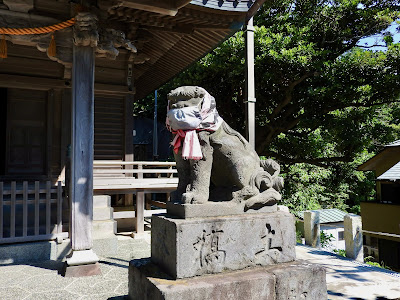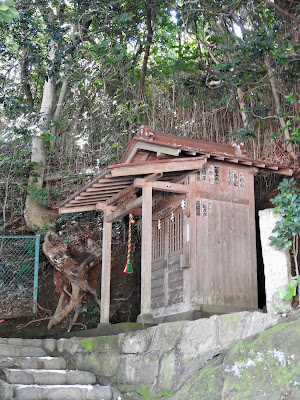目次 / Contents
1) 小動神社 / Koyurugi Shrine
2) 参道 / Approach to Shrine
3) 本殿 / Main Shrine
A. 主祭神 / Main Deity
B. 狛犬 / Komainu : Guardian Dogs
C. 木彫 / Wood Carving
4) 展望台 / Observation Deck
5) 境内の他の神社 / Other Shrines in Precincts
1) 小動神社 / Koyurugi Shrine
 |
お参りするかここで挨拶だけにするかを迷いました。 もしかしたらこの前を通ることはもうないのではないかと思い、 お参りすることにしました。 I and my husband R were walking from Shichirigahama Beach to the Koshigoe Fishing Port. To the east of Koyurugi Point is Shichirigahama Beach, and to the west is Koshigoe Fishing Port. On the way, we saw Koyurugi Jinja Torii ; Gate. I was wondering whether to go and worship or just make an obeisance to a shrine here. I thought that we might not pass in front of this again, so I decided to visit. 小動神社 私は小動神社について何も知りませんでした。 複数の山車 (ダシ) が左の倉庫に保管されています。 Koyurugi Shrine I didn't know anything about Koyurugi Shrine. A few floats (dashi) are stored in the warehouse on the left. |
鎌倉山から七里ヶ浜については下記。
About from Kamakurayama to Shichirigahama, below.
七里ヶ浜から小動神社まで下記。
About from Shichirigahama to Koyurugi Shrine, below.
<余談>
お神輿と山車の違いをご存知ですか?
なので、神輿に人が乗ることは禁じられています。
山車は山型の山頂に神様が降臨するとされています。
なので、山車の内部に人が乗ってお囃子などで神様をもてなします。
山車は、花や人形などで豪華な装飾が施されていることが多いです。
またお神輿は人が担ぎますが、山車は担ぐ必要はないのですね〜。
<Digression>
Do you know the difference between a mobile shrine and a float?
The Gods on mobile shrines are temporarily present when the spirits who are usually in the shrine move to Ujiko town : local worship town or Otabisho, etc.
According to Wiki about Otabisho,
"Otabisho (御旅所, lit. "the trip place") is a facility that serves as the temporary destination or midway resting point of a kami (more accurately the mikoshi) in the middle of its ritual procession."
Therefore, it is forbidden for people to ride on the portable shrine.
A float is said to have a God descend onto the top of the float.
Therefore, people who ride on the float and musicians inside treat the Gods with their hospitality.
Floats are often luxuriously decorated with flowers and dolls.
Also, people carry a mobile shrine, but it is not necessary to carry floats.
2) 参道 / Approach to Shrine
 |
| 一の鳥居 神社境内から国道134号を車が途切れたのを待って撮影しました。 First Torii ; Gate I took a photograph of National Route 134 from the shrine precincts after waiting for cars to pass. |
If you go along the approach, you will find Chōzu-ya.
According to Wiki about Chōzu-ya,
"Chōzu-ya or temizu-ya is a Shinto water ablution pavilion for a ceremonial purification rite known as temizu or chōzu ( 'hand-water'). "
 |
| 手水舎 最近の手水舎 は、コロナのせいで使用されていません。 ここも同様です。 Chōzu-ya Nowadays Chōzu-ya are not used because of corona. The same is true here.  竜の口から水が出ていません。 There is no water coming out of the dragon's mouth. |
 |
| 竜の口から水が出て参拝前に手が清められる日が 早く来ることを願っています。 I hope that the day will come soon when water will come out from the dragon's mouth and our hands will be cleansed before worshiping. |
手水舎の先に階段があり、二の鳥居が見えます。
いつもながら、階段をみると多少躊躇しますが、結局登ることが多いです。
There are steps beyond the Chōzu-ya, and you can see the second torii gate.
As always, I hesitate a little when I look at the steps, but in the end I usually climb.
 |
| 本殿は階段の上にあります。 The main shrine is at the top of the steps.  二の鳥居 / Ni-no-torii : Second Gate |
3) 本殿 / Main Shrine
A. 主祭神 / Main Deity
 本殿と鳥居 |
鳥居と本殿が90度に配置されているのは珍しい気がします。 何か理由があるのでしょうか? 単に地形的な理由なのでしょうか? Main Shrine and Torii I feel that it is unusual for the torii gate and the main shrine to be located at 90 degrees. Is there any reason? Is it just a topographical reason? |
Main Deity
Main Deities are
Yamato Takeru and
Toshigami.
Susanoo governs the ocean and exterminates Yamata no Orochi
which is a legendary eight-headed and eight-tailed Japanese dragon / serpent.
Takeminakata no Kamii is also the deity of Suwa Grand Upper Shrine and is revered as a War God and is the guardian deity of hunting and fishing.
In 1909, Suwa Shrine in Koshigoe Village was moved to Koyurugi Shrine and enshrined.
Yamato Takeru was a royal family of ancient Japan, and is a legendary hero in ancient Japanese history who is said to have conquered Kumaso and Togoku.
Kumaso is a general term for people who are said to have resisted the Yamato kingdom and who are based in the current southern part of Kyūshū, which appears in Japanese mythology.
The reason for its founding was to pray for victory
in the Genpei War (1180 - 1185), so it mainly enshrines War Gods.
According to Wiki about Genpei War
"The Genpei War (源平合戦, Genpei kassen, Genpei gassen) (1180 - 1185) was a national civil war between the Taira and Minamoto clans during the late-Heian period of Japan.
It resulted in the downfall of the Taira and the establishment of the Kamakura shogunate under Minamoto no Yoritomo, who appointed himself as Shōgun in 1192, governing Japan as a military dictator from the eastern city of Kamakura."
The Gods contrast with the origin of the name of the shrine which was a pine sways beautifully even though there is no wind : Koyurugi no Matus.
According to the explanation board of the Shrine,
"The word koyurugi means to quiver or shudder, and it is said to have come from a beautiful pine tree in the area that would flutter even when there was no breeze on the cape."
But when I think about it, Gods are not usually refined or tasteful.
Is it because Gods are connected to the primitive life and desires of human beings?
B. 狛犬 / Komainu : Guardian Dogs
 |
| 狛犬 狛犬がマスクをしているのは、コロナ対策のマスクを 推奨するためなのはわかります。 ですが、頰被り(ホオカブリ)または頭巾(?)を しているのは何故でしょう? 布に文字が書かれていますが読めません。 不敬ながら、日本の昔の泥棒の姿:★を 思い起こすのは私だけでしょうか? 彼らの姿にクスッと笑ってしまいます。 布に文字が書かれていますが読めません。 Komainu: Guardian Dogs I understand that the reason why Komainu : Guardian Dogs wear masks is to recommend us to wear masks against corona. Do they wear headcovers or hoods (?), why are they doing this? Letters are written on the cloths, but I can't read them. I'm irreverent, but am I the only one who remembers the supposed appearance of Japanese thieves in olden times : ★? They gave me a little chuckle.  マスクをしているのでどちらが阿形 (アギョウ) で、 どちらが吽形 (ンギョウ) かはわかりません。 Since they are wearing masks, I do not know which is Agyō : A-style and which is Ungyō : Un-style. |
B. 木彫 / Wood Carving
本殿には立派な木彫が取り付けられています。
機械を使用して彫られたのかと思うほどシャープなエッジです。
もしかすると比較的新しい設置なので、木彫に風雪の中を通り過ぎた趣がまだないのかもしれません。
 |
| 朱雀か鳳凰か? (妻部分) Suzaku : Vermilion Bird or Phoenix? (Front-Gable) |
Fine wood carvings are attached to the main shrine.
The edges are so sharp that I might think they were carved using
a machine.
Perhaps it's a relatively new installation, so the wood carvings may not yet have the taste of passing through wind and snow.
 |
| 竜 大好きな竜(龍)が中心にあります。 (正面の梁上) Dragon My favourite dragon is in the centre. (On the front beam) |
 |
| 玄武? (正面の梁下) Black Tortoise? (Under the front beam) |
At first, I thought Four Symbols : the Azure Dragon of the East, the Vermilion Bird of the South, the White Tiger of the West, and the Black Tortoise of the North, after all I didn't really understand their idea.
正面の梁の両脇
Both Sides of the Front Beam
 |
| 獅子か竜か虎か象か? Are they Lions, Dragons, Tigers or Elephants?   |
4) 展望台 / Observation Deck
境内、海側に展望台があります。
There is an observation deck on the sea side of the precincts.
 |
| 説明板 展望台への階段脇にこの説明板があります。 Explanation Board There is this explanation board on the side of the steps to the deck.   |
 |
| 展望台からの眺め 江ノ島と腰越漁港が見えます。 Views from the Deck You can see Enoshima island and Koshigoe Fishing Port.  江ノ島大橋も見えます。 You can also see the Enoshima Big Bridge. |
 |
| 小動岬の崖 海食の崖は廃墟と似ていて好きです。 Cliff of Koyurugi Point I like sea cliffs because they look like ruins. |
5) 境内の他の神社 / Other Shrines in Precincts
 |
| 左 : 金刀比羅宮 (コトヒラグウ / こんぴらさん) 大国主命 (オオクニヌシノミコト: 別名; 大物主神 / オオモノヌシノカミ) を祭神とし、 航海の安全や海難救助を司る神様です。 ここにふさわしい神様ですね。 右:稲荷神社 稲荷社の主祭神は宇迦之御魂神 (ウカノミタマ) です。 商売繁盛、産業興隆、家内安全、交通安全、芸能上達の神です。 is God who controls voyage safety and rescue. It's the God suitable for here. Right : Inari Shrine The main deity of Inari Shrine is Ukanomitama. It is a god of business prosperity, industrial prosperity, family safety, traffic safety, and improvement of performing arts. |
 |
| 海神社 海神社 (アマジンジャ/カイジンジャ /ワタツミジンジャ) は、 綿津見神 (ワタツミノカミ / 別名 船玉神 / フナタマノカミ) を祀っています。 漁業の神、航海の神です。 Sea Shrine Sea Shrine enshrines Watatsumi God. Watatsumi God is for fishing and navigation. |
 大六天社 |
| 大六天社 (ダイロクテンジン) は、 第六天神 (ダイロクテンジン / 淤母陀琉神:阿夜訶志古泥神 : オモダル・アヤカシコネ) を祭神とした諸願成就の神です。 この日はなぜか階段下で立ち入り禁止になっていました。 Dairokuten Shrine Dairokuten Shrine is a god of fulfillment of various wishes with the sixth Tenjin (Dairokutenjin : Omodaru Ayakashikone) as the deity. For some reason, it was off limits on this day under the steps. |
 |
| ニホントカゲ 帰り際にニホントカゲ (メス) を見ました。 ドラゴンの子供と私は考えています。 Japanese Lizard I saw a Japanese Lizard : Plestiodon Japonicus (female) just before leaving the shrine. I think of this as a dragon child. |
<余談>
下記、鎌倉タイムからの引用。
"小動神社のある小動山の下は小動岬といわれ、東大生だった
太宰治 (1909 - 1948)が、銀座のカフェの店員であった19歳の
田辺あつみ (田辺シメ子 / 1912 - 1930) と心中事件を起こした場所としても有名です。
太宰はじめての心中事件です。
太宰は助かりましたが、田辺あつみは死んでしまいました。
その際太宰が担ぎ込まれた恵風園はいまでは恵風園胃腸病院として同じ場所にいまも残っています。
この時の経験は後に『道化の華』(1935) という作品となっています。"
太宰治は複数回心中を試みて、最後の心中は相手の女性に無理やり引きづり込まれた死に方をしています。
私は彼に同情しません。
<Digression>
According to 'Kamakura Time' about Koyurugi Shrine,
(Translated by me)
"Below Koyurugi Mountain, where Koyurugi Shrine is located, it is said to be Koyurugi Point.
At the Point, a Japanese novelist, Osamu Dazai, a student in Tokyo University, had a committed double suicide incident with Atsumi Tanabe, a 19-year-old shop assistant in a cafe in Ginza.
This is Dazai's first committed double suicide incident.
Dazai was saved, but Atsumi Tanabe died.
Keifuen, where Dazai was carried at that time, still remains in the same place as Keifuen Gastrointestinal Clinic.
The experience at this time later became a work, 'Flowers of Buffoonery' (1935). "
Osamu Dazai (1909 - 1948) had tried committed double suicide multiple times, and the last one was forced to die by his partner's woman.
and the last one is forced to die by the other woman.
I don't sympathize with him.
国道134号へ戻って西へ進み、腰越漁港へ向かいました。
次のセクションは、腰越漁港です。
We returned to National Route 134 and headed west to the Koshigoe Fishing Port.
The next section is about Koshigoe Fishing Port.







0 件のコメント:
コメントを投稿